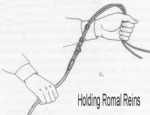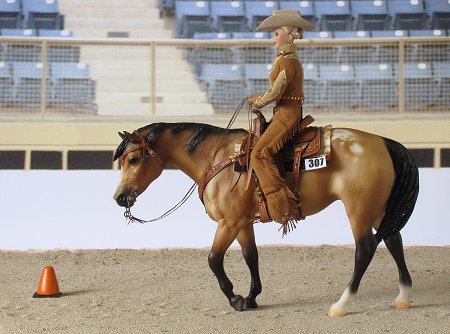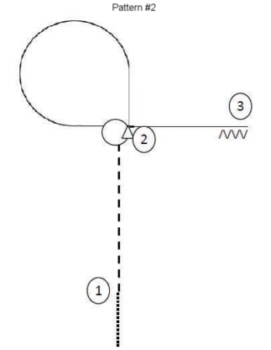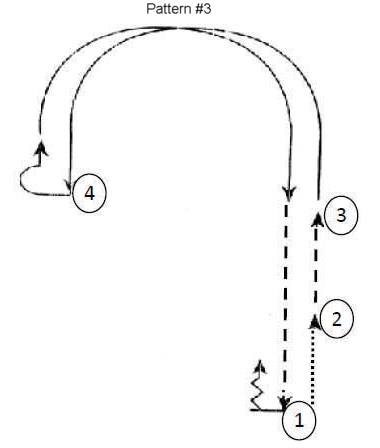IMEHA (International Model Equine Hobbyists Association) was an online photo showing site that existing until 2018. Included on the site were these guidebooks for judging and showing model horses in Performance classes. MEPSA has obtained permission to share the info contained in the guides.
Scoring :: Point Deducts :: Tack :: Rider :: Reins :: Set-Up Options :: Photo Examples
Class Explained as offered in Real Horse World:
Typical Class Routine for Stock Seat Equitation is as follows: All horses are to enter the ring at a walk, whether they enter as individuals or as a class. A judge will designate whether they will use individual patterns or rail work. At some shows the classes will begin with individual pattern work. Rail work may or may not be used for finals classes. Any work on the rail should include a flat-footed, fourbeat walk, a two-beat jog, and a three-beat lope displaying the correct lead. Reversing, if called for, should be done away from the rail. Contestants are expected to stay on the rail at all times and to use the corners of the arena as they are intended when rail work is called for. If a contestant must pass another horse, passing will take place to the inside of the ring of the horse in front. The contestant will take care as to not interfere with the other contestant’s horse by cutting off that horse or getting too close to that horse during passing. Exhibitors shall demonstrate sometime during the class routine the ability to back their horse. The equitation horse should respond instantly and smoothly to all aids given by the rider. There are several patterns for this class and there are beginner, junior and senior divisions.
IMEHA Requirement to Enter:
For the IMEHA entry a doll rider will be required for this class in an arena setting. For the purpose of judging IMEHA the class photo entry will be that of the any part of one of three different patterns shown on this page. There will be no age divisions and the class will be open to adult doll riders. This class will appear only in the Doll Rider Divisions. The rider will be judged 80% for posture, cueing and steering. The horse will be judged 20% on manners and performance of the horse. Please review the Western Pleasure Arena class for its section on proper western gaits.
You Score Stock Seat Equitation on the following:
Basic Riding Position for Equitation:
Rider should sit in the saddle with:
(1) Legs hanging straight and slightly forward of stirrups.
(2) Knees slightly bent and weight directly over balls of feet.
(3) In either position the stirrup should be short enough to allow the rider’s heels to be lower than their toes.
(4) Body should always appear comfortable, relaxed and flexible.
(5) Feet should be placed in the stirrup with weight on ball of the foot. Consideration, however, should be given to the width of the stirrups, which varies. If stirrups are wide, the foot may have the appearance of being “home”, when in reality the weight is properly carried on the ball of the foot. The rein hand should be above horn and as near to it as possible.
Position in Motion:
(1) Rider should sit to the jog and not post.
(2) The rider should be tight in the saddle at the lope.
(3) There should be very little tell tale use of aids to control the horse.
(4) Any exaggerated shifting of the rider’s weight is a strong penalty.
Scoring and Penalties:
The following are penalties which will result in a disqualification of this class:
(1) Going off pattern or failure to complete the pattern as written.
(2) Working on the wrong side of the cones.
(3) The taking of four steps or more with the front legs in opposition of the pattern.
(4) Any balking or refusal of command where pattern is delayed— a refusal is stopping and backing two strides.
(5) Horse runs away or rider fails to guide where it becomes impossible to discern whether the entry is on pattern.
(6) Equipment failure that delays the completion of pattern.
(7) The dropping of a rein that contacts the ground.
(8) Two handing reins, a finger between romal reins, or more than one finger between split reins.
(9) Touching the saddle.
(10) The fall of either horse or rider.
(11) Any knocking over of any marker.
(12) Rearing or other actions of horse which endanger horse and/or rider.
(13) Failure to have correct exhibitor number displayed.
(14) Failure to wear appropriate western attire.
The following are considered faults and should be judged accordingly:
(1) Horse opens mouth or tosses or raises head excessively.
(2) Any unnecessary aid given by the rider such as: jerking of reins, petting, spurring, unnecessary talking.
(3) Horse shows it is anticipating signal or early lead changes.
(4) Rider loses a stirrup or a free hand hold.
(5) Wrong lead or break of gait.
(6) Stopping the horse rough or crooked.
(7) Failure of rider to have horse to maintain a pivot foot.
(8) Imprecise pattern work or rough transitions.
(9) Horse showing resistance when cued or reined.
(10) Rider posting the jog.
(11) Rider with a stiff, artificial, or unnatural body, leg, arm and/or head position.
(12) Rider with poor position in the saddle.
(13) Rider with a loose leg with open knee, legs too far forward or back.
(14) Rider with toes pointed down.
(15) Rider with shoulders held crooked or arms held in a straight, unbent position.
(16) Reins too long, too short, or uneven.
Extra Credit Should Be Given If:
(1) Split reins are used, the rein should fall on the same side as the rein hand.
(2) A romal rein is used; romal should fall on the opposite side from the rein hand (romal is usually held in the rider’s other hand).
(3) Entry Number is shown on saddle blanket or on rider’s back.
(4) A judge doll is used.
Points Should Be Deducted If:
(1) Model exhibits excessive speed for gait assigned.
(2) Model is on the wrong lead.
(3) Model appears to display a slowness in any gait or loss of forward momentum resulting in an animated and/or artificial gait at the lope.
(4) Rider touches horse or saddle with free hand.
(5) Model’s head is carried too high.
(6) Model’s head carried too low tip of ear below the withers.
(7) Model is over flexed or has a strained neck in head carriage, so the nose is carried behind the vertical.
(8) Model displays excessive nosing out.
(9) Model displays an opening mouth excessively.
(10) Rider uses spurs forward of the cinch.
(11) Model appears sullen, dull, lethargic, emaciated, drawn or overly tired.
(12) Model appears agitated has ears back, tail twirled, etc.
(13) Model displays quick, choppy or pony strides.
(14) Reins are draped to the point that light contact is not maintained.
(15) Model is overly canted at the lope. *When the outside hind foot is further to the inside of the arena than the inside front foot.
Required Tack:
A western stock saddle without tapaderos. The saddle can have either squared or rounded skirts with the current style leaning toward squared. In most breeds the current style also is to omit the rear cinch, sometimes adding “tabs” to occupy the rear girth slots; however, if a rear cinch is used, it must have a connecter strap to the front cinch. Breastplates are optional. Silver should not be counted over a good working outfit. A saddle pad resting under all pressure points is recommended but not required equipment. A western style bridle (browband, one ear, two ear, with or without throatlatch) with a curb bit including a curb strap or curb chain. Standard snaffle bit and bosal hackamores are permitted on horses 4 and under (5 and under for Arabians and Appaloosas). Romal reins and split reins are both legal; Romal reins are usually seen on Arabians, Morgans, and NSH. Missouri Fox Trotters usually wear a noseband and current style includes older buck stitched saddle. MFT current style saddle pads are white with white ribbon in mane and forelock.
Prohibited Tack:
Nosebands or cavessons (except Missouri Fox Trotter and National Spotted Saddlebred/Walking Horse). Any type of martingale or tiedown, tapaderos, roping reins, crops or whips, mechanical hackamores are also prohibited. Split reins may not be knotted or attached to each other (stickwax is of course permitted in model horses). Rider may not have more than one finger between split reins or any fingers between the reins of a rein and romal.
Optional Equipment: Any type of protective boots such as skid, bell, split or rundown boots, leg wraps and bandages.
Rider:
Attire is jeans, trousers or pants over western boots, long sleeved shirts, (vest, tie and jacket are also permitted), shotgun chaps, belt through loop, and western hat. The doll rider’s posture must be addressed because if you can’t get it correctly then don’t use it. Doll must sit down in the saddle, the back should be straight. There should be a straight vertical line between the rider’s ear, the elbow and the heel. The knee and toe of the boot should also be in a straight line, knees and feet turned straight along the side of the horse and heel of boot pointed down. The rein arm upper arm should be tucked into the side of the rider, elbow is bent and the forearm parallel to the ground. The free arm is held free and straight down with palm flat and lightly touching the leg. You may place ONE finger between your split reins and there is no rule as to which one – though most riders place their index finger between. If using romal reins the romal hand is carried with hand holding romal at the length of which the romal is straight and not curved. Hand then rest quietly near or on the doll’s leg. Hackamore or snaffle reins the rider’s hands should be carried near the pommel and not further than four inches (to scale) out on either side of the saddle horn. Rein hand wrist(s) of either rein is turned slightly inward. The doll rider’s head should be looking straight forward as if rider is looking through the horse’s ears.
Rein Hand Holds:


Horses are shown on a reasonable loose rein. Extremes such as too tight or too loose should be penalized.



Set-Up Options:
Arena Fencing Required (Indoor or Outdoor Arena)
Types of Fencing Allowed:
- Painted or Natural
- Post and Rail
- Post and Plank
- Chain Link
- Solid Plyboard
- Plyboard with Top Rail
- Post with Drape Rope
- Stock Tube Pipe Rail
- Interior Arena Wall
Footing Required:
- Dirt
- Sand
- No grass base allowed
- No rock base allowed
Backboard or Natural Setting (Indoor or Outdoor)
Props Required:
- 1 to 5 cones
Description Required:
- Pattern number #1 thru #3, plus the numbered portion or movement of the pattern must be stated. Any other additional reference or comment may be added.
Examples of the Four Breed Divisions:

Western Stock Seat Equitation
Stock Breed Entry
Watch Your Back, shown as an Appendix QH, is a Peter Stone TB, Thespian. Owned and shown by Andrea Robbins. Entry is shown performing IMEHA, Western Equitation Pattern #3, Step #2: Jog from #2 to #3. Entry is jogging toward the third marker.

Western Stock Seat Equitation
Arabian Breed Entry
Aer Kharysma, shown as a Pintabian gelding, is a Peter Stone Arabian customized by Betsy Andrews. Owned and shown by Andrea Robbins. Entry is shown performing IMEHA, Western Equitation Pattern #3. Entry is standing at the first marker awaiting the judge’s signal to begin the course.

Western Stock Seat Equitation
TB/WB or Sporthorse Breed Entry
Wingman, shown as a palomino Thoroughbred gelding, is a Peter Stone TB, Midas. Owned and shown by Andrea Robbins. Entry is shown performing IMEHA, Western Equitation Pattern #3, Step #2: Jog from #2 to #3. Entry is jogging toward the third marker. Notice that the rider is holding the split reins with one finger between the reins.

Western Stock Seat Equitation
Other Breed Entry
Goody Four Shoes, shown as an American Mustang, is a Breyer Indian Pony, Sheza Good Sport. Owned and shown by Andrea Robbins. Entry is shown performing IMEHA, Western Equitation Pattern #3, Step #1: Walk from #1 to #2. Entry is walking toward the second marker.
IMEHA Stock Seat Equitation Patterns:

Pattern #1:
- Walk from #1 to #2.
- At #2, jog circle right, go on to #3.
- Stop at #3, hindquarter pivot 90 degrees left.
- At #4, stop and back.

Pattern #2:
- Walk to #1.
- Jog to #2.
- 360 degree turn to the left.
- Lope left lead around and back to #2.
- Simple lead change.
- Lope right lead to #3.
- At #3, stock and back.

Pattern #3:
- Begin #1 and walk to #2.
- Jog from #2 to #3.
- Lope half circle to #4 in left lead.
- Stop at #4, 180 degree turn to right.
- Lope a half circle to cone 3 in the right lead.
- At #3, jog and continue to #1.
- Stop at #1 and back.

Correct Western Equitation Seat:
There should be an imaginary line from the rider’s ear thru the center of the waist and down thru to the back of the heel. The toe should line up with the rider’s front of knee. The boot heel should be turned straight in alignment with horse’s side with the rider’s knee and calf turned inward. The rein hand should be above the horn and as near to it as possible.
